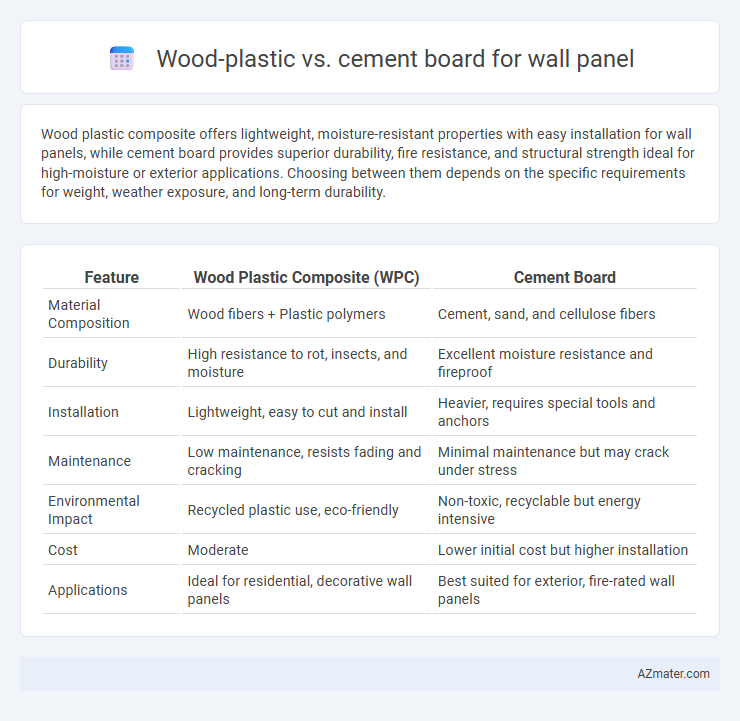Wood plastic composite offers lightweight, moisture-resistant properties with easy installation for wall panels, while cement board provides superior durability, fire resistance, and structural strength ideal for high-moisture or exterior applications. Choosing between them depends on the specific requirements for weight, weather exposure, and long-term durability.
Table of Comparison
| Feature | Wood Plastic Composite (WPC) | Cement Board |
|---|---|---|
| Material Composition | Wood fibers + Plastic polymers | Cement, sand, and cellulose fibers |
| Durability | High resistance to rot, insects, and moisture | Excellent moisture resistance and fireproof |
| Installation | Lightweight, easy to cut and install | Heavier, requires special tools and anchors |
| Maintenance | Low maintenance, resists fading and cracking | Minimal maintenance but may crack under stress |
| Environmental Impact | Recycled plastic use, eco-friendly | Non-toxic, recyclable but energy intensive |
| Cost | Moderate | Lower initial cost but higher installation |
| Applications | Ideal for residential, decorative wall panels | Best suited for exterior, fire-rated wall panels |
Introduction to Wall Panel Materials
Wood plastic composite (WPC) and cement board are two popular wall panel materials offering distinct advantages in construction and interior design. WPC combines wood fibers and plastic polymers, providing moisture resistance, durability, and eco-friendliness, while cement board is composed of cement and reinforcing fibers, known for its fire resistance, strength, and suitability for wet areas. Selecting between wood plastic and cement board depends on factors like application environment, aesthetic preference, and performance requirements.
What is Wood Plastic Composite (WPC)?
Wood Plastic Composite (WPC) is a durable material made by combining wood fibers with thermoplastics such as polyethylene or polypropylene, offering enhanced resistance to moisture, decay, and insects compared to traditional wood. WPC panels are lightweight, eco-friendly, and require minimal maintenance, making them suitable for wall paneling in both interior and exterior applications. In contrast to cement boards, WPC provides better thermal insulation and flexibility while delivering a natural wood-like appearance.
Understanding Cement Board Panels
Cement board panels are composed of a mixture of cement and reinforcing fibers, offering superior durability, moisture resistance, and fireproof qualities compared to wood plastic panels. Their non-organic composition makes them less susceptible to mold, rot, and warping, making cement boards ideal for high-humidity or exterior wall applications. Cement board provides a stable, long-lasting base that can support heavy tiles or finishes, enhancing structural integrity in both residential and commercial wall panel installations.
Durability: WPC vs Cement Board
Wood plastic composite (WPC) offers superior resistance to moisture, rot, and insect damage, making it highly durable for exterior wall panels in humid or wet conditions. Cement board excels in fire resistance and structural strength, providing long-lasting performance for heavy-duty applications and areas with extreme weather exposure. Both materials resist warping and cracking, but WPC's composite nature ensures better flexibility, while cement board maintains rigidity under high stress environments.
Moisture and Weather Resistance
Wood plastic composite (WPC) wall panels offer superior moisture resistance compared to cement boards due to their non-porous structure, preventing water absorption and reducing the risk of mold and rot. Cement boards are highly durable and resistant to weather elements but can absorb moisture if not properly sealed, leading to potential degradation over time. For exterior applications in humid or wet environments, WPC panels provide enhanced weather resistance and lower maintenance requirements.
Installation Process Comparison
Wood plastic composite (WPC) wall panels offer easier installation due to their lightweight properties and snap-fit or tongue-and-groove designs, which reduce the need for specialized tools and fasteners. Cement boards require more labor-intensive procedures, including cutting with specialized saws, moisture-resistant preparation, and mechanical fastening, making the installation process more time-consuming and demanding skilled labor. WPC panels also minimize the need for surface preparation and drying time, providing a faster and cleaner installation compared to cement board systems.
Maintenance Requirements
Wood plastic composite (WPC) wall panels require minimal maintenance due to their resistance to moisture, rot, and insects, making them ideal for humid environments. Cement board panels demand periodic inspection for cracks and potential water damage, especially in exterior or high-moisture applications, but they are highly resistant to fire and mold. Both materials benefit from occasional cleaning, yet WPC often avoids the need for repainting or sealing that cement boards might require over time.
Aesthetic Options and Design Flexibility
Wood plastic composite (WPC) wall panels offer a wide range of aesthetic options, including wood-like textures and customizable colors that mimic natural wood grains, enhancing contemporary and rustic designs. Cement boards provide a more uniform, industrial look with limited color variability but can be textured or painted to achieve diverse finishes suitable for modern, minimalist interiors. WPC panels allow easier cutting and shaping, granting greater design flexibility for intricate patterns and curved installations compared to the rigid, heavy cement boards.
Cost Considerations
Wood plastic composite panels generally offer lower upfront costs compared to cement boards, making them a budget-friendly option for wall paneling projects. Cement boards, while more expensive initially, provide greater durability and resistance to moisture, potentially reducing long-term maintenance expenses. Evaluating lifecycle costs is essential for choosing between the cost-effectiveness of wood plastic panels and the robust investment of cement boards in wall applications.
Environmental Impact and Sustainability
Wood plastic composite (WPC) wall panels offer enhanced environmental benefits due to their use of recycled plastics and wood fibers, reducing landfill waste and demand for virgin materials. Cement boards, while highly durable and fire-resistant, rely on energy-intensive cement production that contributes significantly to carbon emissions. Choosing WPC panels supports circular economy principles through material reuse, whereas cement boards have a larger ecological footprint despite their longevity.

Infographic: Wood plastic vs Cement board for Wall Panel
 azmater.com
azmater.com